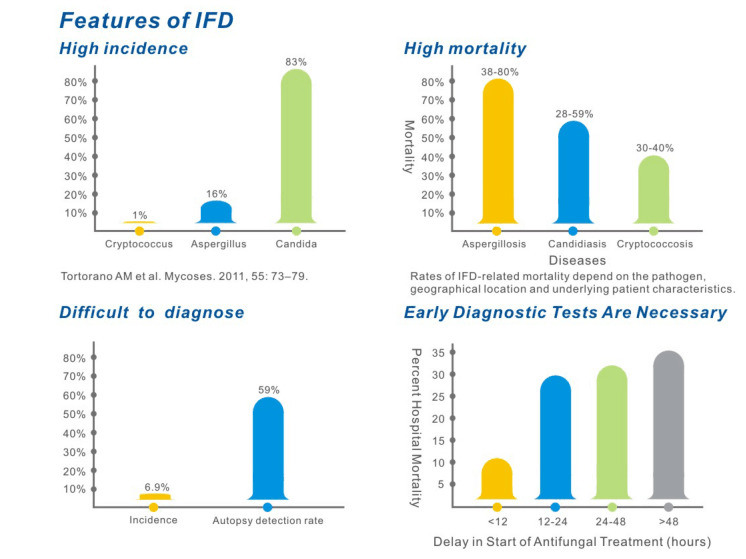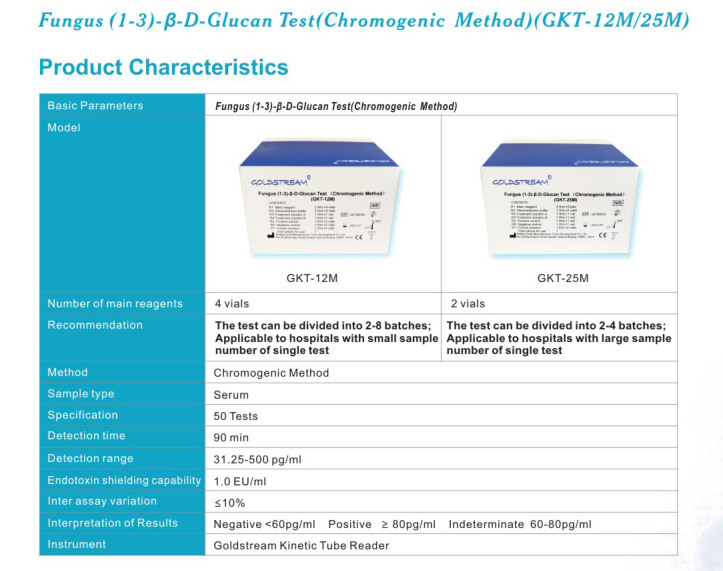There is an increasing incidence of fungal infections by opportunistic pathogens, especially in immuno-compromised patients (1, 2, 3). Invasive fungal diseases, as opportunistic infections, are common among hematological malignancy and AIDS patients and account for a growing number of nosocomial infections, particularly among organ transplant recipients and other patients receiving immunosuppressive treatments (4, 5). Many fungal diseases are acquired by inhaling fungal spores originating from the soil, plant detritus, air-handling systems and/or exposed surfaces. Some opportunistic fungi are present in/on human skin, the intestinal tract, and mucous membranes (6, 7). Diagnosis of invasive mycoses and fungemias is usually based on non-specific diagnostic or radiological techniques. Recently, biological markers of fungal infection have been added to the available diagnostic methods (8).Â
Opportunistic fungal pathogens, include Candida spp., Aspergillus spp., Fusarium spp., Trichosporon spp., Saccharomyces cerevisiae, Acremonium spp., Coccidioides immitis, Histoplasma capsulatum, Sporothrix schenckii, and Pneumocystis jirovecii. These pathogenic organisms can be detected by the products of Era Biology.Â


Product Advantages
Cost &Â time savings
Do not need to do parallel test
Experiment can be carried out in batches, suitable for both small and massive amount of samples
Each channel work independently, the experiment can be started at any time
Quick and quantitative
Results within 2Â hours reported as quantitative values
Convenient
Ready-to-use reagents
Don't need to recreate a standard curve
Accurate
Contains quality control, to ensure the accuracy of the experiment
Compatibility
Closed system, easily compatible
Recommended by the EORTC/MSG Consensus Group
As one of the mycological criteria for the diagnosis of invasive fungal disease
Patients at High Risk for IFD(8)
Immuno-compromised patients are at high risk for developing invasive fungal disease, which is often difficult to diagnose. Affected patients populations include:Â
- ICU patients
- HIV patients
- Burn patients
- Respiratory patients
- Stem Cell and Organ Transplant patients
- Cancer patients undergoing chemotherapy
1. Gullo A. Invasive fungal infections[J]. Drugs, 2009, 69(1): 65-73.Â
2. Kontoyiannis DÂ P, Marr KÂ A, Park BÂ J, et al. Prospective surveillance for invasive fungal infections in hematopoietic stem cell transplant recipients, 2001-2006: Overview of the Transplant-Associated Infection Surveillance Network (TRANSNET) Database[J]. Clinical Infectious Diseases, 2010, 50(8): 1091-1100.Â
3. Xu WÂ M, Shui W, Lin JÂ C, et al. The serum glucan level and pathological changes of antifungal treatment for lower respiratory tract infection of Candida albicans[J]. Medical mycology, 2014: Myu068.Â
4. Alangaden GÂ J. Nosocomial fungal infections: Epidemiology, infection control, and prevention[J]. Infectious disease clinics of North America, 2011, 25(1): 201-225.Â
5. Hou TÂ Y, Wang SÂ H, Liang SÂ X, et al. The screening performance of serum 1, 3-Beta-D-glucan in patients with invasive fungal diseases: AÂ meta-analysis of prospective cohort studies[J]. PloS one, 2015, 10(7): E0131602.Â
6. Lass-FLörl C. The changing face of epidemiology of systemic fungal infections[J]. New Horizons in Translational Medicine, 2015, 2(2): 11.Â
7. Nucci, M. And Anaissie, E. 2009. Fungal infections in hematopoietic stem cell transplantation and solid organ transplantation -Â Focus on aspergillosis. Clin. Chest Med. 30: 295-306.Â
8. De Pauw, B., Walsh, T. J., Donnelly, J. P. Et al. 2008. Revised definitions of invasive fungal disease from the European Organization for Research and Treatment of Cancer/Invasive Fungal Infections Cooperative Group and the National Institutes of Allergy and Infectious disease Mycosis Study Group (EORTC/MSG)Concensus Group. Clin. Inf. Dis. 46: 1813-1821.Â
9. Tortorano AÂ M, Dho G, Prigitano A, et al. Invasive fungal infections in the intensive care unit: AÂ multicentre, prospective, observational study in Italy (2006-2008)[J]. Mycoses, 2012, 55(1): 73-79.Â
10. Lassâ€FLörl C. The changing face of epidemiology of invasive fungal disease in Europe[J]. Mycoses, 2009, 52(3): 197-205.Â
An anesthetic (or anaesthetic) is a drug to prevent pain during surgery, completely blocking any feeling as opposed to an analgesic. A wide variety of drugs are used in modern anesthetic practice. Many are rarely used outside anesthesia, although others are used commonly by all disciplines. Anesthetics are categorized into two classes: general anesthetics, which cause a reversible loss of consciousness, and local anesthetics, which cause a reversible loss of sensation for a limited region of the body while maintaining consciousness. Combinations of anesthetics are sometimes used for their synergistic and additive therapeutic effects. Adverse effects, however, may also be increased. We produce anesthetic raw materials like tetrcacain, lidocaine prilocaine. These three anesthesia products are in commercial quantity.
Prilocaine structure:

Tetracaine Anesthetic Drug,Anesthetic Powder,Anesthetic Cream Pharmaceuticals,Bupivacaine Base Anesthetic Pharmaceuticals
Jinan Jianfeng Chemical Co., Ltd. , http://www.pharmachemm.com